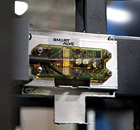
This electronic superheat management system is designed to eliminate the need for excess amounts of refrigerant storage.
The refrigeration technology selected was Hill Phoenix Second Nature® technology for both its low- and medium-temperature display cases and walk-in coolers.
“We’ve been focusing on green technology in our stores and look to Hill Phoenix to bring us new ideas and technologies,” said Cary Nix, manager of engineering for the New York/New England division of The Stop & Shop Supermarket Co. “The glycol-CO2 technology is the first application of this technology in the state and fits into our focus on sustainability.”
MEDIUM TEMP
Stop & Shop selected the Second Nature medium-temperature system with glycol for its display cases and walk-in coolers. Among the key features are:Use of Propylene Glycol Helps Cut Refrigerant Charge in Half:The system offers an advanced refrigeration technology that is designed to cut refrigerant charge by more than 50 percent over a standard DX system. The system achieves this by replacing a significant amount of HFC refrigerants with food-grade propylene glycol. At this location another step was taken to lower potential greenhouse gas emissions by replacing HFC-404A with HFC-407A, a refrigerant with almost one-half of the global warming potential of R-404A. “Even though it has only been a few months, by using this system with glycol, we’ve already seen a reduction in the HFC refrigerant charge,” explained Nix. “We’re using 1,100 pounds of refrigerant compared to about the 2,600 you would typically need for a store this size.”
Use of Variable-Speed Drives:The medium-temp system at the West Hartford store uses two 7½-hp pumps with variable-speed drives. Incorporating the drives on the glycol pumping station allows the system to provide precise capacity control throughout the operation, said Nix.
According to Hill Phoenix, using the variable-speed drives with end-of-loop pressure controls on the glycol circulating system allows the system to optimize the flow rates at each display case and cooler. By producing only the refrigerant capacity each refrigerated unit needs, excess cooling is eliminated and a store can achieve an average energy savings of 40 percent over traditional pumping systems.
Use of Chilled Glycol:In addition to its sustainability benefits, the use of the chilled glycol system and its ability to control product temperatures is especially effective for medium-temperature applications such as meat, seafood, and produce cases, officials said, adding that with the Second Nature system temperature control is more stable, thus eliminating large temperature swings.
Tony McCullough, inside sales engineer at Hill Phoenix explained, “When using the chilled glycol system, we’re able to solve the traditional temperature peaks and valleys of high-pressure DX systems, which in turn ensures less product shock and shrinkage. This results in improved product quality for Stop & Shop customers.”

This direct expansion cascade system is for low temperature display cases and walk-in freezers.
LOW TEMP
The West Hartford Stop & Shop selected a Second Nature direct expansion cascade system for its low-temperature display cases and walk-in freezers. While most low-temperature systems use HFC refrigerant as the primary means to refrigerate freezers, this system (SNLTX2) uses CO2 condensed by the medium-temperature compressor system. According to Hill Phoenix, this is the same compressor system that is used to chill the propylene glycol for the medium-temp cases and walk-in coolers. CO2 is considered a natural refrigerant and component of the environment, has excellent thermodynamic and transport properties, and has good material compatibility, the manufacturer said.It is said to provide a significant decrease in refrigerant charge. With 650 pounds of R-744 (CO2), the cascade system is able to reduce costs; CO2 is an inexpensive refrigerant, costing only a fraction per pound compared to the price per pound for HFCs, the company said.
The system also employs low-temperature technology with an electronic superheat management system. The proprietary SmartValve Superheat Management system reduces refrigerant requirements and eliminates the need for excess amounts of refrigerant storage within the system that typically accommodates wide swings in ambient conditions, the manufacturer said, noting the technology reduces the pull-down time after defrost from 32 minutes to 11 minutes, resulting in an approximately 9 percent reduction in kilowatt usage.
COMPRESSOR TECHNOLOGY
The Stop & Shop system incorporates a relatively new compressor technology through use of Copeland Intelligent Store Discus® compressors. “These compressors have all the onboard diagnostic controls built into the compressor, which allows Stop & Shop to monitor everything right on the spot,” said McCullough. “This is a much more efficient way to monitor the system and makes it easier if there’s a need to troubleshoot.”GOING GOLD
For recognition of its sustainability accomplishments, Stop & Shop West Hartford has been awarded GreenChill Gold-Level certification from the GreenChill Advanced Refrigeration Partnership, a voluntary EPA partnership with food retailers to reduce refrigerant emissions and decrease their impact on the ozone layer and climate change.The certification program recognizes individual stores for using environmentally friendlier commercial refrigeration systems. The Stop & Shop West Hartford store has achieved Gold-Level certification for using only non-ozone depleting refrigerants, achieving an average HFC refrigerant charge of 1.218 pounds of refrigerant per 1,000 Btuh total evaporator cooling load, and a storewide annual refrigerant emissions rate of not more than 12 percent. According to Nix, installing this technology is a test for the company, and they are looking at every aspect - reduction in refrigerant and refrigerant leaks, analyzing installation ease, and reductions in energy and maintenance costs. “If it performs the way we expect, it may be a technology that we can move forward with in the future,” he said.
For more information, go to www.hillphoenix.com.
Publication date:06/06/2011

Report Abusive Comment